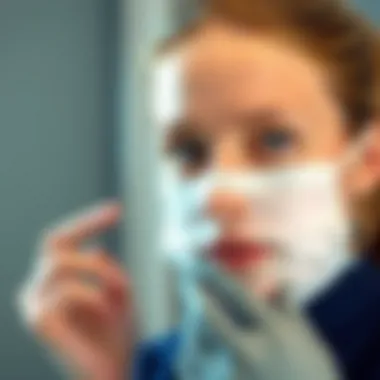Why Full Body Mole Checks are Essential for Skin Health


Intro
Skin health is not just about cosmetics or hydration; it extends to being vigilant about changes in our bodies, particularly concerning our skin. Regular full body mole checks serve as a proactive measure against potential dangers, especially skin cancer. With melanoma cases at a notable rise, understanding how to effectively monitor our skin is paramount.
A full body mole check enables early detection, which significantly improves treatment outcomes. Beyond prevention, it cultivates a keen awareness of skin health, urging individuals to evaluate their bodies systematically. This article will shed light on the importance of these checks, dissecting the preparation, process, and benefits that come with them.
It's essential to know what to look for and why seeing a dermatologist is not merely an option but a necessity for maintaining good health.
The Role of Full Body Mole Checks
In the realm of preventative health care, full body mole checks can be the gatekeepers to early intervention. Detecting suspicious moles or skin changes promptly is crucial, as this is often the line between minor treatments and life-altering procedures.
What to Expect During the Examination
When you visit a dermatologist for a full body mole check, expect a thorough examination. Here’s generally what happens:
- Undressing: You'll be asked to undress to your comfort level so the dermatologist can examine your skin comprehensively.
- Skin Assessment: The doctor will inspect every inch of your skin, looking at moles, freckles, and other markings.
- Photography: Some dermatologists may take photographs of moles for comparison during future visits.
- Discussion: After the examination, there will be a discussion about any findings, the meaning of your skin’s characteristics, and if any further analysis or treatments are required.
Why It's Imperative to Schedule Regular Checks
In the fast-paced world we live in, health checks might often fall to the bottom of our to-do lists. However, the importance of regular skin screenings cannot be understated. As they say, "An ounce of prevention is worth a pound of cure." Here are a few compelling reasons:
- Early Detection: Most skin cancers are highly treatable when caught early.
- Expert Guidance: A dermatologist can provide tailored advice based on individual skin types, which is invaluable.
- Data Tracking: Regular checks assist in tracking changes in moles over time, crucial for assessing growth or changes in color, shape, or size.
"Regular skin checks are a crucial part of proactive health management. Ignoring them can lead to dire consequences like advanced skin cancer.”
Risk Factors for Skin Cancer
Understanding what increases your risk for skin cancers is the next step after realizing the importance of checks. Here are some common factors:
- Family History: If you have relatives who have had skin cancer, your risk may be heightened.
- Skin Type: Lighter skin types are generally more susceptible to skin damage.
- Sun Exposure: Regular exposure to UV radiation, whether from the sun or tanning beds, increases risk.
- Age: The risk increases with age, making regular checks even more vital for older adults.
Self-Examination Techniques
While seeing a dermatologist is recommended, self-examinations are an essential part of skin health management. Here's how to do one:
- Find a good spot: Choose a well-lit area with a full-length mirror.
- Check your body: Use a hand mirror to inspect hard-to-see areas like your back, ears, and the soles of your feet.
- Follow the ABCDEs: Check moles for Asymmetry, Border irregularity, Color change, Diameter larger than pencil eraser, and Evolving size or shape.
By incorporating self-examinations into your routine, you create a culture of skin awareness that can potentially save your life.
In summary, a full body mole check is more than just a routine appointment; it's an integral part of maintaining skin health. By fostering awareness and making it a priority, we protect ourselves and embrace proactive health care.
Understanding Skin Health
Understanding skin health is crucial for a myriad of reasons. The skin isn’t merely a protective barrier against the outside world; it plays a vital role in our overall well-being. Healthy skin reflects an individual’s internal health, often acting as an indicator for conditions that lie beneath the surface. The connection between skin and health is intricate and knowing how to read the signs can empower individuals to take necessary steps toward better health.
One of the fundamental aspects of skin health is its role in immunity. The skin acts as the first line of defense against pathogens, helping to ward off infections. When the skin is compromised, whether due to damage or disease, it can increase the risk of infections. Moreover, certain skin conditions can indicate systemic issues; for example, persistent rashes or discoloration can be signs of underlying health problems that may need further examination.
In addition, skin health plays a significant part in mental well-being. A good complexion can bolster confidence, while conditions such as acne or eczema can lead to psychological distress. Addressing skin issues not only improves physical appearance but also enhances self-esteem and quality of life.
Furthermore, understanding how to maintain skin health extends beyond treatments. Preventive measures such as consistent sun protection, hydration, and nutrition are key. By emphasizing these practices, individuals can foster a proactive approach, reducing the risk of serious conditions like skin cancer.
In summary, understanding skin health encompasses its role in immunity, its psychological impact, and the importance of preventive measures. This comprehensive view underscores the significance of regular checks, such as full body mole checks, which can harbor insights into one’s overall health.
Moles: An Overview
Moles, often seen as harmless marks on the skin, are much more than mere beauty spots or blemishes. They reflect a person's skin health and can signal changes that might require attention. The significance of understanding moles lies in their potential relation to skin conditions, including skin cancer.
Why Focus on Moles? Moles can develop for several reasons, such as genetics or sun exposure. Recognizing how these factors influence mole development is crucial. By gaining insight into what constitutes a normal mole vs. a concerning one, individuals can take proactive measures in pursuing skin health.


This section is particularly beneficial for those who wish to cultivate a deeper awareness of their skin. With skin cancer being one of the most common cancers worldwide, understanding moles is a practical step in ensuring safety and longevity.
"Being informed about skin health can be a game changer. You can’t manage what you don’t measure."
What Are Moles?
Moles, or nevi, are small growths on the skin that occur when skin cells called melanocytes grow in clusters. Usually tan, brown, or black, they can appear anywhere on the body. Moles may be flat or raised, and their shape, size, and color can differ significantly. Most moles are harmless, but some can change over time, which is why monitoring them is essential.
Types of Moles
Understanding the types of moles can help distinguish between what is normal and what may be concerning. Each type offers insight into skin conditions that warrant attention.
Congenital Nevi
Congenital nevi are moles that are present at birth. Their size can vary significantly, ranging from small spots to larger patches covering substantial areas of skin. One key characteristic is that these moles can carry a slightly higher risk of developing into melanoma compared to acquired moles.
For many individuals, congenital nevi are a natural part of their aesthetics, making them a familiar topic of conversation. However, their unique feature lies in the potential complication of malignant transformation, which makes periodic check-ups critical.
Atypical Moles
Atypical moles differ from standard moles in that they exhibit irregularities in shape, color, and size. Often bigger than common moles, these variants can be more than just cosmetic concerns. Their atypical nature means they may require further examination to rule out melanoma or other skin-related issues.
The presence of atypical moles often indicates a genetic predisposition to skin cancer, making familiarity with them a proactive choice for monitoring skin health. Ignoring these signals could have dire consequences.
Acquired Moles
Acquired moles develop over time and can emerge during childhood, adolescence, or even adulthood. They are common and usually harmless. However, what sets acquired moles apart is their tendency to change. Such changes—whether in size, color, or shape—should always prompt a more in-depth examination.
It's essential to recognize acquired moles as part of one's skin journey. They can provide clues about sun exposure and general health. Thus, while many acquired moles pose little concern, vigilance remains key.
By understanding these types of moles, individuals can cultivate a comprehensive approach to skin monitoring. Not only does this knowledge assist in identifying skin cancers early, but it also encourages a culture of awareness and proactive care.
The Need for Full Body Mole Checks
Regularly checking your moles isn’t just a good idea; it’s a vital part of taking charge of your skin health. Many might think a mole here or there is harmless, but the reality is a tad more serious. Skin cancer, particularly melanoma, continues to be a major health challenge. This is precisely why understanding the importance of full body mole checks can be a game changer.
Detecting Skin Cancer Early
Early detection of skin cancer can significantly improve survival rates. When caught in its initial stages, treatments can be a lot less invasive, and the odds of a full recovery dramatically increase. Full body mole checks allow for a comprehensive view of skin changes. Remember, not all skin cancers show obvious symptoms right off the bat.
Consider this: you may notice a new mole or a weird change in an existing one, like a new color or shape. That’s a red flag. An early mole check can help catch these changes before they evolve into something more serious. As they say, an ounce of prevention is worth a pound of cure. And it couldn’t be more true when it comes to your skin.
Identifying Change in Existing Moles
Moles can change over time. A mole that seemed benign months ago might not be so friendly now. Regular assessments help in spotting those changes. It’s not just about looking at your skin; it’s a comprehensive evaluation of what’s normal for you.
Utilizing the ABCDE method can be particularly helpful:
- Asymmetry: One half doesn’t match the other.
- Border: Irregular, scalloped, or poorly defined edges.
- Color: Not uniform, with shades of brown, black, or even tan.
- Diameter: Bigger than the size of a pencil eraser.
- Evolution: Any change in size, shape, or color.
If a mole starts breaking these rules, it’s a signal to have it checked by a professional.
"The best way to avoid a surprise is to keep an eye on what’s there."
Establishing Baseline Skin Health
Conducting full body mole checks also helps in creating a baseline of your skin health. This initial assessment can guide future evaluations. Knowing how your skin looks and feels at your healthiest assists in identifying changes down the road. When you have records or even just a solid mental picture of your skin’s normal conditions, you can easily spot abnormalities.
Additionally, dermatologists often recommend that a baseline should be established in early adulthood. Factors like sun exposure, lifestyle choices, and family history can dictate your skin's behavior, making baseline checks even crucial. With this information, if changes arise, you have a point of reference to discuss with healthcare providers.


Guidelines for Conducting a Mole Check
Ensuring that your skin remains healthy extends beyond simple maintenance routines. The explication of guidelines for conducting a thorough mole check cannot be overstated. When it comes to identifying potential health issues, especially skin cancer, understanding the process of how to effectively perform a mole check is essential. With the right guidelines, individuals can empower themselves to spot concerning changes and seek medical attention sooner rather than later.
Preparing for a Mole Check
Preparation is key when embarking on your journey to monitor your skin health. Getting ready for a mole check involves more than just knowing where your moles are located. Here are vital steps:
- Choose the Right Environment: Finding a well-lit room where you can see your skin clearly is crucial. Natural light is often the best; position yourself in front of a mirror or use a hand-held mirror in conjunction with a larger one.
- Gather Proper Tools: Having tools handy makes the process smooth. You might want a comb or brush for your hair, a hairdryer, and possibly a smartphone to take images of your moles for later reference.
- Wear Minimal Clothing: Options like a swimsuit or underwear can help you to easily access moles on various parts of your body without the fuss of managing clothing.
Preparing in a structured manner sets the tone for an effective check. It allows you to focus on your skin, ensuring no area is overlooked.
Self-Examination Techniques
Once you're prepared, it's essential to carry out the check using effective self-examination techniques. Understanding these to spot red flags can be a matter of life and death. Here’s how to perform a thorough self-exam:
- Start from the Head: Begin with your scalp and work your way down. Either part your hair or use a comb to ensure no area is missed.
- Utilize Mirrors: Check your back using two mirrors. It might be tricky, but having perspective can help reveal any unusually shaped moles you might have missed.
- Examine the Front and Back: Don’t just focus on the front of your body. Make sure to check areas like the backs of your ears, under your breasts, and your groin.
- Look for Asymmetry: A key red flag in identifying potentially dangerous moles is asymmetry. If one half doesn’t match the other in shape or color, that’s a concern.
- Compare Sizes: Using the ‘pencil eraser’ rule helps. If a mole is larger than a pencil eraser, it's worth signaling to a healthcare provider.
- Color Consistency: Look for even color throughout the mole. Any irregularities or multiple colors can signal a problem.
These techniques ensure you are diligent while checking your skin, enabling you to catch any abnormal changes that require further investigation.
When to Consult a Dermatologist
Having the knowledge of when to consult a dermatologist can be as crucial as performing the checks themselves. Understanding the signs that warrant professional attention is vital. Here are some guidelines:
- Changing Moles: If you notice a mole that has altered in size, shape, or color, it is time to seek medical help.
- New Growths: Any new moles that appear, especially after the age of 30, should be examined by a dermatologist.
- Itching or Bleeding: A mole or skin growth that itches, bleeds, or becomes crusty is worth a consultation, as it may indicate an underlying issue.
- Family History: If skin cancer runs in your family, regular checks with a dermatologist become even more essential.
It’s always better to be safe than sorry. Regular communication with a dermatologist can help catch potential issues early, often leading to better outcomes.
Recognizing these signs empowers you to take charge of your skin health and navigate consultations with healthcare professionals more effectively.
By following these guidelines for conducting a mole check, individuals can enhance their skin health, empower themselves to act promptly, and ultimately, contribute significantly to early detection of potential issues.
Risk Factors for Skin Cancer
Understanding the risk factors associated with skin cancer is paramount in the prevention and early detection of this pervasive disease. Skin cancer—especially melanoma—doesn't discriminate and can affect anyone regardless of gender or age. However, certain factors can heighten the chances of developing skin cancer, making it crucial for readers to recognize these risks.
Preventive Measures
Taking proactive steps can significantly reduce the likelihood of skin cancer. Here are some effective preventive measures tailored for all skin types:
- Regular Skin Checks: Apart from full body mole checks, it’s wise to monitor your skin frequently for unusual changes—whether it’s a new mole or alterations in existing moles. Knowing your baseline can serve as a strong defense.
- Proper Sun Protection: Sunscreen is not just a summertime accessory. Wearing a broad-spectrum sunscreen with SPF 30 or higher, even on cloudy days, is essential. Apply liberally and reapply every two hours or immediately after sweating or swimming. Be sure to cover all exposed skin, including easily forgotten areas like ears and the back of the neck.
- Protective Clothing: Remember that clothing can act as armor against harmful UV rays. Consider wearing long-sleeved shirts, wide-brimmed hats, and UV-blocking sunglasses. These simple additions can drastically enhance your skin's defenses.
- Avoid Tanning Beds: The allure of a perfect tan may be tempting, but tanning beds emit harmful UV radiation. Opting for self-tanning lotions or bronzers can provide a sun-kissed glow without risking your health.
By integrating these preventive measures into your daily routine, you can empower yourself and your loved ones to lower the risks associated with skin cancer.
Understanding UV Exposure
Ultraviolet (UV) radiation plays a significant role in skin cancer development. This invisible threat comes from natural sources like the sun and artificial sources like tanning beds. Here’s what you should know about UV exposure:
- Types of UV Radiation: There are two main types of UV rays that are harmful to the skin:
- Time of Day: The sun's rays are strongest between 10 a.m. and 4 p.m. During these hours, it’s essential to take extra precautions. If you must be outside, seek shade whenever possible.
- Geographical Location: Individuals living closer to the equator or at higher altitudes are at an increased risk of UV exposure. This factor underscores the need for vigilant skin protection regardless of one’s environment.
- Skin Type: Those with lighter skin tones tend to burn more easily and have a higher susceptibility to UV-related skin damage. However, it's important to note that people of all skin colors can develop skin cancer.
- UVA: These rays penetrate deep into the skin and can lead to premature aging and skin cancer.
- UVB: These rays are primarily responsible for sunburn and play a crucial role in the development of skin cancer.
By understanding UV exposure and its implications on skin health, individuals can make informed choices and implement protective measures effectively.
"Awareness and education about the risk factors associated with skin cancer can significantly impact early detection and prevention."
The conversation about risk factors for skin cancer cannot be overstated. By applying the knowledge gained from understanding preventive measures and UV exposure, individuals can take tangible steps toward safeguarding their skin health.
Latest Research and Findings


Recent studies have increasingly highlighted the crucial role of full body mole checks in the early detection and management of skin cancers. These endeavors not only focus on enhancing the methods used to identify potential malignancies but also emphasize the significance of integrating cutting-edge technology and research insights into everyday skin health practices. With skin cancer rates on the rise, it’s vital to stay abreast of the latest findings that can greatly influence prevention strategies.
Advancements in Skin Cancer Detection
Innovative techniques are revolutionizing how dermatologists conduct skin examinations. Tools such as digital dermoscopy have emerged, allowing for high-resolution imaging of moles. This method goes beyond the naked eye, enabling practitioners to identify irregularities with greater precision. Following is a list of some promising advancements in skin cancer detection:
- Reflectance Confocal Microscopy (RCM): This method provides real-time, high-resolution imaging of skin layers and allows dermatologists to make more informed decisions about suspicious lesions without immediately resorting to biopsies.
- Artificial Intelligence (AI)-powered Tools: AI systems are increasingly able to match suspicious mole images with vast databases of known cases, improving diagnostic accuracy. They can quickly analyze whether a mole displays characteristics typical of melanoma or other skin cancers.
- Genetic Testing: Recent research is also looking at genetic markers that can indicate a higher risk for developing melanoma. This approach can provide a more personalized risk assessment, helping clinicians guide preventive measures effectively.
The integration of these advancements signifies a major leap forward. They foster better early detection rates, which are vital for patient outcomes. As such, regular full body mole checks have never been more imperative, especially as these tools become more accessible within dermatological practices.
The Impact of AI in Dermatology
Artificial Intelligence (AI) is reshaping various fields, and dermatology is no exception. The impact of AI on the detection of skin cancers is profound, as it can analyze images of moles with an accuracy that sometimes surpasses human dermatologists. Key benefits of AI include:
- Efficiency: AI algorithms can process thousands of images in mere seconds. This speed enables quicker diagnoses and less waiting time for patients.
- Accessibility: With mobile apps powered by AI, individuals can conduct preliminary self-checks, which may highlight areas needing professional attention. This democratizes access to skin health monitoring.
- Training Opportunities: AI can also assist medical professionals in training. By analyzing vast datasets, AI can help train new dermatologists to spot atypical moles more effectively.
- Data-Driven Insights: The use of AI can uncover patterns in skin cancer development that may not be immediately apparent. This knowledge can lead to improved public health strategies in skin cancer prevention.
"The future of dermatology lies in amalgamating human insight with the analytical prowess of AI," notes an expert in the field. It’s clear that embracing these technologies could enhance proactive skin care and, ultimately, patient outcomes. The role of full body mole checks is only going to grow as these tools become standard practice.
For more information on advancements in dermatology, refer to sources such as National Institutes of Health, and American Academy of Dermatology.
Frequently Asked Questions
Understanding the nuances surrounding mole checks is paramount for effective skin health management. In this section, we tackle some of the most common queries regarding full body mole checks, which not only provide clarity but also empower individuals to take charge of their skin health. By addressing these questions, we pave the way for informed decision-making and proactive skin care.
How Often Should One Get a Mole Check?
When it comes to the frequency of mole checks, there is no one-size-fits-all answer. Several factors play into how often one should undergo a thorough examination.
- Age and Skin Type: Generally, individuals with light skin who sunburn easily or have a family history of skin cancer should consider annual checks, starting from their late teens or early twenties.
- Change in Moles: If a mole develops changes in size, shape, or color, it warrants immediate attention regardless of the last mole check date.
- Personal History: Those who have had skin cancer previously should have more frequent check-ups, as the risk of recurrence is higher.
As the old saying goes, "An ounce of prevention is worth a pound of cure." Regular monitoring can significantly decrease the risk of serious skin conditions.
What to Do If a Mole Changes?
A change in a mole can elicit concern, but understanding how to respond is crucial. Here are steps to consider when you notice alterations:
- Monitor: Keep an eye on the mole for any additional changes over a few weeks.
- Document: Take photos to track its progression. Documentation aids in communicating changes with your dermatologist.
- Consult a Dermatologist: If the alterations persist or you have other risk factors, schedule a visit. Dermatologists might recommend a biopsy to rule out malignancy.
Changes in moles can be indicators of potential skin issues. Don't hesitate to seek professional advice.
Are All Moles Dangerous?
Not all moles are created equal. While many moles are benign, some can signify skin cancer, particularly melanoma. Recognizing the characteristics of a concerning mole can mean the difference between early detection and late diagnosis. Here’s a brief overview:
- Common Moles: Typically small, uniform in color and shape, and not prone to change.
- Atypical Moles: Larger than normal with irregular borders or varied colors. These may require additional monitoring.
- Suspicious Moles: Any mole that appears irregular, bleeds, itches, or changes in appearance should be examined as soon as possible.
In essence, while the majority of moles won’t pose health risks, vigilance is key. Knowing your skin can empower you to act swiftly if needed, solidifying the role of full body mole checks in maintaining skin health.
Ending
As we wrap things up, it's clear that regular full body mole checks play an essential role in skin health management and cancer prevention. The skin, being the largest organ of the human body, acts as a barrier and protector. However, it also serves as a window to our overall health, making it crucial to monitor changes carefully.
The Importance of Regular Monitoring
The importance of regular monitoring of moles cannot be overstated. Identifying changes in moles or new growths early can be a lifesaver, particularly when it comes to skin cancer. Statistically, skin cancer is one of the most common forms of cancer, yet it is also one of the most treatable when caught early. Regular inspections can aid in recognizing these changes—like size, color, or shape—immediately, catching potential issues before they escalate.
- Regular Assessments: Setting a schedule for mole checks ensures that you are consistently aware of your skin's condition. A good practice is to perform self-examinations every month, and combine this with a professional check-up once a year.
- Enhanced Awareness: The more familiar you become with your skin, the more likely you are to notice any oddities that crop up. This awareness can lead to earlier intervention, which is often key in successful treatments.
- Customized Strategies: Regular check-ups with dermatologists will allow skin care plans tailored to one's specific risk factors and skin type, fostering a proactive approach.
"An ounce of prevention is worth a pound of cure." This quote rings especially true for skin health. The proactive approach prevents surprises down the line, leading to peace of mind and better outcomes.
Encouraging Proactive Skin Care
In promoting proactive skin care, we encourage individuals, especially women of all ages, to take the reins of their dermatological health. Here are steps to make that easier:
- Stay Educated: Knowledge is power. Learn about the forms of skin cancer, risk factors, and what constitutes a normal mole versus an atypical one.
- Utilize Tools: Use apps and online resources like American Academy of Dermatology for reminders or educational content on how to perform self-examinations.
- Consult Experts: Don’t shy away from visiting your dermatologist. Early detection is often aided by expert insight, particularly in analyzing moles or skin irregularities.
- Healthy Habits: Adopt skin-friendly habits like wearing sun protection daily, avoiding tanning beds, and leading a balanced diet rich in antioxidants. This combined with regular mole checks paves the path to healthier skin.







